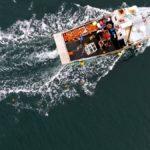Greg Trowse, Luna Ocean Consulting
The tide is one of the most accurately predictable natural phenomena. Following standard practice accurate long-term predictions of water levels are generated using harmonic analysis. However, when applied to tidal currents harmonic analysis does not accurately capture turbulence, eddies, and large flood-ebb asymmetries. This is especially true in high-energy channels of interest for tidal energy developments where fast flowing waters passing over bathymetric features and through non-uniform coastlines result in significant spatial variation, as well as irregular flow velocity profiles.
For tidal energy projects to succeed, we need to better understand how tidal flows vary in time and space. This information is needed to optimize tidal turbine locations and power outputs, reduce turbine failures, improve energy predictions, and reduce operational costs.
How do tidal flows change in time? – We are developing LunaTide, an innovative approach that combines the strengths of harmonic analysis with additional site information to produce highly accurate long-term predictions.
How do tidal flows change in space? – We are developing a technique for flow field mapping that uses hundreds of drifting sensors tracked by satellites and Unmanned Aerial Vehicles (aka drones).

